|
12/23/2013 Isvara Pranidhana (surrender)Isvara Pranidhana is the fifth Niyama and it refers to surrendering to some power greater than ourselves. Especially when things are difficult, it can be harder to find this surrender, we tend not to trust that life itself has our best interests at heart. It is during these times, however that surrender becomes most important. This week's restorative practice can help to surrender any holding in the body and breath so that spiritual surrender is a bit easier. Isvara Pranidhana enables you to move along with the flow of life without hesitation or struggle. Understanding that pain is just one small part of the process of your unfolding. There is also pleasure, beauty and support all around you. Chin Mudra Touch the tips of the index finger and thumb together while extending the other fingers. Turn the palms downward and rest the hands on the knees. Benefits: Cultivates silence in the mind and honors the divine within all of creation. 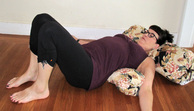 Supported Heart Opener Set up two bolsters perpendicular to mat with folded blanket on the one toward the back of the mat. Sit on folded blanket or on floor facing away from bolsters. Lie back so that shoulder blades and upper back are supported by shorted bolster and the head and neck are supported by the taller bolster. The upper line of the shoulders and arms should fall in between the bolsters. If the elbows to not readily reach the floor, support with more folded blankets. Either straighten legs out to floor or rest knees over bolster. Rest 5-10 minutes.  Supta Balasana (Supported Child's Pose) Kneel straddling a long bolster. Place a second bolster over first with end of bolster in front of your low abdomen. A third bolster can go under the far end of the second bolster or use a folded blanket or block to support under it. Extend front of body over second bolster and rest forehead on backs of hands. Rest up to 5 minutes.  Legs in the Chair Lie on back with legs in the seat of a chair, or in this case the ottoman. Place arms away from sides and palms up. Rest 15 minutes.
0 Comments
The third and fourth Niyamas are Tapas or determination, and Svadhyaya or self-study, two ideals that are paramount to making yoga a part of our daily lives. Tapas is the determination to meet life’s challenges head on using all the tools at your disposal whether they are in yoga, in meditation or in some other aspect of life. It means having enough energy and determination to stay with the path you have chosen for yourself, not wavering from what you know will help you to grow. Svadhyaya means being able to look at your challenging situations in a different light. Learning from your past mis-steps and being able to put that knowledge to good use going forward. You see your actions and their motivations non-judgmentally with wisdom and clarity. This week's practice helps us to get in touch with that part of ourselves that can watch what happens in the body and mind as we practice so that we can cultivate tapas and learn from the practice of svadhyaya. Enjoy! Mustikam Mudra Bring soft fisted hands together touching the middle digits of the knuckles together with the thumbs pointing upwards joined along their length. Hold hands in front of abdomen. Benefits: Cultivates determination and discipline, brings awareness to digestion and assimilation. Sakshi Mudra Bring palms together in front of the heart. Spread knuckles away from each other so that only tips of fingers and heels of hands are touching. Bend thumbs into open space between palms so that the thumb touches the base of the pinkie finger. Benefits: Cultivates clarity and self-study, relaxes tension around the face and throat. 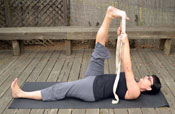 Supta PadangusthasanaLie on the back with the knees bent. Variation I: Draw your right knee into your chest and lengthen the left leg onto the floor. Wrap a strap around the ball of your foot and extend the leg into the air. Reach the hands up the strap until the elbows are straight but the shoulders are still grounded.  Cobra to Childs Pose Begin in Childs Pose with the arms overhead on the floor. Inhale keep hands where they are and move torso through arms to come into a backbend with pelvis pressing towards floor. Exhale return to Childs Pose. Repeat 5-10 times with the breath. Knee Plank From all fours, lean the pelvis forward so that the body and upper thighs line up like a plank of wood. Keep the belly taut and lift the chest forward. Hold for 3 breaths and release back into all fours. 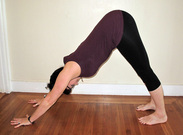 Downward Facing Dog Begin on all fours with hands slightly forward of shoulders. Turn toes under and lift knees off floor. Keep shoulders wide and palms flat, press thighs and sit bones back, scooping belly in. Hold for 5-10 breaths. 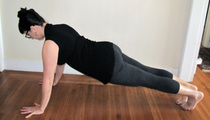 Plank Pose From Downward Facing Dog, inhale and bring shoulders over wrists as you swing pelvis forward, creating a straight line with the spine and legs. Hold for 3-5 breaths and release to all fours. 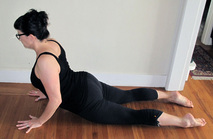 Bhujangasana Lie on the belly with the hands under the shoulders. Press pubic bone into floor and lengthen legs behind you. Inhale and press upper body away from floor keeping shoulders back and chest broad. Hold 5-10 breaths and release chest to floor. 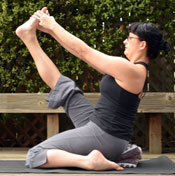 Krounchasana Sit on a block with the left leg in Virasana and the right foot on the floor. If you cannot sit in Virasana, sit cross-legged with the left leg. Either wrap strap around sole of foot or hold sole of foot with both hands. Inhale open chest and lean back taking left foot off floor and bringing left knee to chest. Exhale and extend the left leg straight. Hold 10-20 breaths then release and change sides.  Savasana Lie on back with legs straight and feet relaxed to sides. Move arms away from sides slightly and turn palms to face ceiling. You may use support under the knees for low back pain; and a folded blanket under the head if needed. Rest 5-15 minutes. This month we will explore the second limb of Patanjali’s eight limbed path of yoga, called the Niyamas. The five Niyamas, or moral observances, harness the effect of our sensory perceptions allowing for more mental and emotional equanimity. In Sanskrit they are Saucha or purity, Samtosha or acceptance, Tapas or determination, Svadhyaya or self-study and Isvara Pranidhana or surrender. This week we discuss Saucha and Samtosha. Firstly, Saucha or purity relates to purification of all parts of our being. From eating the right foods in appropriate amounts, to keeping our surroundings free from clutter, to allowing space for quiet practices and contemplation. Samtosha or acceptance means being able to react to life's challenges and victories from a place of equanimity. Being able to release the struggle of daily life and allow those things you cannot change to lessen their grip on your mind as you consciously look for the positive learning and blessing in each situation. As we practice the twists below, feel the purification inherent when the abdominal organs are wrung out, a practice especially nice after the Thanksgiving holiday. Also accept where your body is right now and try not to push yourself deeper into the postures than is comfortable or necessary. Enjoy! 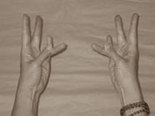 Vishuddha Mudra Press thumbs onto sides of ring finger at middle joint, extend all others. Rest hands with palms up. Benefits: Activates and purifies the throat Chaturmukham Mudra Press tips of index, middle, ring, and little fingers together. Extend thumbs upwards and hold hands in front of abdomen. Benefits: Opens breath in the front of the body, instills a sense of contentment and acceptance.  Bharadvajasana Draw feet to left side of pelvis, knees stay in front of torso. Try to press left hip towards floor as you raise left arm overhead. Exhale and twist belly, ribs, chest and head to right. Release left arm to outside of right thigh, right arm can support behind the back. Hold for up to 2 minutes, then release and change sides.  Table Twist Begin on all fours. Inhale lift right arm out to side. Exhale press right arm under left armpit lowering right shoulder to floor. Continue to press left hand into floor for balance. Can also raise left knee up pressing left ball of foot into floor. Be careful not to put too much pressure on your head.  Adho Mukha Svanasana Begin on all fours with hands slightly forward of shoulders. Turn toes under and lift knees off floor. Keep shoulders wide and palms flat, press thighs and sit bones back, scooping belly in. Hold 1-3 minutes, release into Child's Pose.  Uttanasana Stand in Tadasana. Inhale arms overhead. Exhale and bend forward from hips. Engage quadriceps and draw belly in as you press heels into floor, and sit bones upwards. Hold up to 1 minute. Release back into Tadasana by drawing hands onto hips and lifting entire torso up as a single unit.  Ganeshasana Begin standing with feet slightly wider than hips distance apart. Keeping the knees soft, begin to swing arms around the body like two elephant trunks, lightly tap the body with the hands wherever they land as you twist right and left. Go faster or slower depending on how it feels to you for about 1 minute. Then slow down the swinging until you are again standing still. 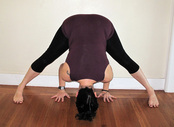 Prasarita Padottanasana Stand with feet wide apart. Bend forward from hips placing hands between feet. Release spine forward with crown of head facing floor. Hold up to 1 minute, then return to standing by drawing hands onto hips and lifting entire torso up as a single unit. 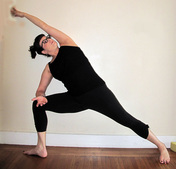 Parsvakonasana (Side Angle Pose) Stand with feet wide apart. Turn right foot out 90 degrees and left foot in 30 degrees. Inhale arms out from shoulders. Exhale and bend right knee. Bring right elbow to right knee or right hand to a block behind the right foot. Raise right arm overhead and stretch entire left side of body. Hold 5-10 breaths then release and change sides. 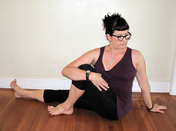 Marichyasana Sit in Dandasana. Bend right knee and either step the foot down in front of right sit bone, or cross over and step outside of right thigh. Inhale and sit up tall through torso, wrap right arm around front of left knee, left arm reaches to floor behind torso. Exhale and twist into left leg, belly, ribs, chest and head Hold for 5-10 breaths then release and change sides. 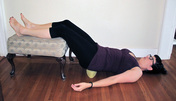 Instant Maui Lie on back with legs in the seat of a chair. Lift pelvis off floor and place block or a folded blanket under pelvis. Place arms away from sides and palms up. Rest 15 minutes. |
Index:Archives:
September 2022
I attend Cheryl's class regularly and feel that my practice has improved immensely over the past few years due to her expert coaching. Her teaching style is clear and compassionate and her previous experience in teaching adults is evident in her organized approach and easy to understand instructions. I also appreciate that Cheryl not only teaches us about how to correctly position ourselves, but also touches on many aspects of yoga philosophy, which in turn has deepened my personal practice and heightened my awareness of the connection between mind and body, breath and relaxation. |

 RSS Feed
RSS Feed
